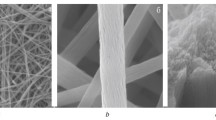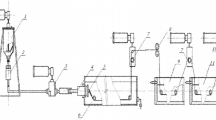The process of producing a carbon fibre material containing silver based on polyacrylonitrile nanofibres is investigated. It is shown that immobilizing silver during the spinning step is a more efficient method than surface modification of the material.
Similar content being viewed by others
Explore related subjects
Discover the latest articles, news and stories from top researchers in related subjects.Avoid common mistakes on your manuscript.
Water conservation has become a major current issue as a result of anthropogenic processes due to constant accumulation of toxic substances and heavy metals in water reservoirs [1, 2]. Moreover, such reservoirs become a favorable environment for the growth of bacteria and viruses. Therefore, the creation of new facilities for the treatment of water returning to the environment, as well as for cleaning and disinfection of drinking water from microbiological contamination, is of principal importance. Promising directions for solving such environmental objectives should include the use of different filtering materials [3, 4], including the fibre materials containing silver, since silver has excellent antibacterial properties [5].
This article presents the results of research on the production of nanofibre materials containing silver and based on polyacrylonitrile (PAN). Access to raw material, the antimicrobial activity of silver, and good filtration capacity of nonwowen nanofibre materials [6] make it advantageous to develop a method for producing this type of material based on silver immobilized in the fibre structure of the polymer.
12% solutions of PAN in dimethylacetamide (DMA) containing silver nitrate were used for electrospinning the fibres, and the reduction of silver ions to metal was combined with the process of thermal oxidation of the fibre. It is noted that addition of AgNO3 to solutions of PAN in dimethylformamide (DMF) and dimethyl sulfoxide (DMSO) is not possible due to formation of a precipitate: a black precipitate in DMF, and a red one in DMSO.
Based on the results of the study of rheological properties of solutions of PAN with silver nitrate [7] and their jet formation ability in an electric field, using “NanospiderTM” equipment we found that only solutions of PAN in DMA containing silver nitrate in an amount of not more than 0.5% exhibit the ability to form fibres. Optimal conditions for capillaryless electrospinning were determined for these solutions (solution viscosity: 6.6 Pa·s; electrical conductivity: 232.8 micro Siemens per cm; applied voltage: 35–40 kV; distance between the electrodes: 190 mm), and samples of nanofibre PAN material with silver nitrate content of 0.5% were obtained for further investigations. A significant increase in the viscosity of PAN solutions at AgNO3 content above 1% makes it impossible to process the solution into nanosized fibre material by electrospinning.
Structuring of the solution in the presence of AgNO3 complicates the process of obtaining films by the coagulation method, which primarily manifests in substantial morphological change of the film surface. Instead of a uniform, clearly expressed fibrillar nature of the surface with a 10–15 nm microrelief, for the film formed from a PAN solution not containing silver nitrate (Fig. 1a), in the process of depositing films from 1-2% solutions of AgNO3 a grainy surface layer forms with a microrelief of up to 35–60 nm (Figs. 1c, 1d). Large spherical formations of up to 60–100 nm are visible on the surface micrographs, which can appear due to decreasing diffusion processes in the polymer coagulation because of high viscosity of the solution.
Micrographs of film surfaces – those for the plain film, and for the film containing 0.5% silver nitrate – differ insignificantly, although, according to the 3D-images, microrelief height increases on average by a factor of 4–5 (Figs. 1b, and 2a, 2b).
Since the introduction of silver into the nanosized fibre PAN material provides the possibility of obtaining sorptive carbon fibre filtering materials with disinfectant properties, we investigated the effect of silver particles on the carbonization processes under model conditions.
PAN fibres containing 0.5 wt. % silver particles were obtained by immobilizing silver nitrate into the structure in the fibre spinning solution, and by coating the surface of the fibrous material followed by a reduction of silver ions into metal by heat treatment under the conditions of thermal oxidation of PAN. The plain PAN fibre was treated with an aqueous solution of AgNO3, and by thermal oxidation under comparable conditions.
A significant decrease in the temperature of maximum decomposition rate (an average of 300 deg) was revealed from the derivative curves describing the decomposition of nanosized fibre samples containing silver by thermal oxidation in an inert environment. As a consequence, in the early stages of thermolysis a heat resistant polymer degradation product is formed, which provides a higher yield (20–40 %) of carbon fibre at carbonization temperatures of 750–900 °C. As seen from the table, for the carbonization temperatures 750-800-900 °C the yield of carbon fibre for the case of silver nitrate immobilization is 62-59-54%, which is higher than the corresponding values for the nanofibre PAN material not containing silver, 57-54-46% respectively (Figs. 3 and 4). The method of surface modification of the material by treatment with a solution of AgNO3 to enhance the carbonizing ability of the PAN nanofibre is less effective (see Table 1), which explains the less uniform distribution of silver in the fibre. Higher efficiency of the method of introducing silver into the fibre at the spinning stage proves this. The presence of silver particles in the standard PAN fibre also increases its carbonizing ability.
During thermolysis in air, silver particles showed no effect on the coking processes. There is only a slight shift towards a lower temperature of the maximum decomposition rate υmax (by 50 degrees), and its increase (small for a nanofibre material, and almost two-fold for the standard PAN fibre).
References
S. Nikolaev, Energiya, 11, 65–68 (2009).
A. S. Kopylov and V. F. Ochkov, Teploenergetika, 4, 56–58 (2010).
T. V. Druzhinina, Khim. Volokna, 4, 4–10 (2012).
M. P. Zverev and Z. Z. Abdulkhakova, Fibrous Chemisorbents [in Russian], Narodny Uchitel, Moscow (2001) 176 p.
V. A. Zhukovskii, V. A. Khokhlova, et al., Ros. Khim. Zh., 55, No. 3, 24–27 (2011).
P. I. Basmanov, V. N. Kirichenko, et al., High-Performance Gas Cleaning From Aerosols With Petryanov Filters [in Russian], Nauka, Moscow (2003) 271 p.
A. I. Sidorina and T. V. Druzhinina, Khim. Volokna, 4, 23–27 (2012).
Author information
Authors and Affiliations
Additional information
Translated from Khimicheskie Volokna, No. 6, pp. 29–32, November – December, 2015.
Rights and permissions
About this article
Cite this article
Sidorina, A.I., Druzhinina, T.V. Preparation of Nanofibre Material Containing Silver. Fibre Chem 47, 453–455 (2016). https://doi.org/10.1007/s10692-016-9712-7
Published:
Issue Date:
DOI: https://doi.org/10.1007/s10692-016-9712-7








